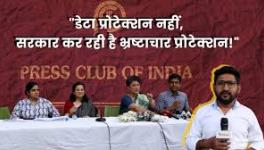MP Slips Further in Crucial Indices, Congress Blames Previous BJP Govt.
Image for representational use only.Image Courtesy : The Indian Wire
Bhopal: The Economic Survey of Madhya Pradesh 2018-19, tabled in the state Assembly on Tuesday, July 10, has revealed that the state has further slipped in its rankings in health, financial, education and poverty indices in the nation. The state ranked 27th in the poverty index, 25th in the national health index and 23rd in education index out of 29 states.
The survey report has exposed the truth behind the erstwhile Bharatiya Janata Party government’s claim that “Madhya Pradesh is no more a ‘bimaru’ (the acronym for Bihar, Madhya Pradesh, Rajasthan and Uttar Pradesh, which resembles the Hindi word for sick) state and now it will move towards ‘prosperity’.”
The survey revealed that the state is home to 68.23 lakh poor families registered under the Mahatma Gandhi National Rural Employment Guarantee Scheme. Approximately 2.34 crore people are living Below Poverty Line (BPL) and the state is ranked 27th followed by Uttar Pradesh and Bihar in the poverty index.
In terms of the hunger index, the state is ranked 27th, just ahead of Bihar and Jharkhand which shows the worsening living conditions of the people in the state. The survey states that only 11.4% of villagers and 51% of city dwellers get tap water. Tap water is supplied only to 23% of houses. The rest meet their water needs through well, hand pumps and other sources.
Also read: MP: Finance Commission Chief Busts BJP’s Claim of Development
Referring to the national family health survey, the economic survey said, “Malnourishment has acquired critical proportion as 42% of children up to the age of five and stunted, 25.8 % are wasted and 42.8 % are underweight. Infant mortality rate is highest in the nation at 47 per 1,000, though the national average is 33 per 1,000. The state has the second highest mortality rate among children below the age of five after Assam. More than 52% women in the state are anaemic.”
“The major challenge is to bring the situation of nutrition at par with the national average with the help of policy change, intervention in the programmes and community participation,” the survey observed.
In the crucial education sector, the survey has ranked the state 23rd in the country. In the era of computer education, only 15.7 % kids receive computer education. More than 71% schools don’t have electricity connection. Around 19,000 schools have only one teacher while 4,451 schools have only one room. The dropout rate in primary school is 4.69 %, up from 5.10% in the previous year.
Dropout Rates Higher Among Girls
“The yawning gap of literacy rate of national average of 52.2% and that of the state average of 44.7% in 1999 was bridged in 2001 when the national and state rates stood at 64.8% and 63.7%, respectively. But today the state stands at 23rd position in the list of 29 states in the literacy rate,” the survey said.
It further stated, “In 2011 census, the averages of the state and the national stood at 73% and 69.3%. But the 10-year increase in the literacy rate was not according to expectations from 2001 to 2011. This has happened because of low enrolment in primary schools. In the year 2015-16, the enrolment was again very low at 78.9% against 87.3% of the national average.”
The survey also expressed concern over excessive exploitation of groundwater for irrigation purposes. It observed that more stress should be laid on developing water storage capacity. Irrigated land has increased by 6.99% to 98,76,000 hectare in 2018-19.
The Shivraj Singh Chouhan-led Bharatiya Janata Party was in power for the last 15 years in the state. In the run up to the recently held Assembly elections, the BJP had claimed that ‘in the last one and half decade, Madhya Pradesh has succeeded to remove ‘Bimaru’ tag by creating better basic facilities in health, education, roads and power sector, and now the state is rapidly moving towards ‘Samridh Madhya Pradesh (Prosperous Madhya Pradesh).’
Despite the state economy being agriculture-driven, there was an increased focus on industrial development to give the state GDP an additional push
According to the report, 26.82 lakh people were registered at the employment office till December end last year, out of which 2,434 lakh applicants were literate. There was an increase of 1.16% in numbers of government employees (regular). There were 7,35,559 government employees on March 31, 2018 which is 0.57% less than the previous year.
Hours after the economic survey tabled in the Assembly, Congress held accountable to the erstwhile BJP government for it. In a joint press conference, state Congress media in-charge Shobha Oza and vice-president Abhay Dubey, lambasted the BJP.
“The economic survey is an eye-opener. The state is counted as one of the most backward in the country. The previous government failed to elevate our poor, could not provide adequate health services or education for children,” Shobha Oza said.
Also watch: Missing Adarsh Villages of Madhya Pradesh
Abhay Dubey claimed the economic situation is serious in the state. “Chapter 10 of the Economic survey betrays that per capita income of the state is Rs 90,998, when the national average is Rs 1,26,699. In per capita, our state is among the last five rankings with Bihar, Jharkhand, Orissa,Uttar Pradesh and MP,” he said.
Congress argued that under the BJP rule, agricultural growth suffered contrary to the claims of the former government. “Agricultural growth was -1.9% in 2013-14, 1.3% in 2014-15, -4.1% in 2015-16, 32.7% in 2016-17 and 0.1% in 2017-18,” Dubey said.
Get the latest reports & analysis with people's perspective on Protests, movements & deep analytical videos, discussions of the current affairs in your Telegram app. Subscribe to NewsClick's Telegram channel & get Real-Time updates on stories, as they get published on our website.
























